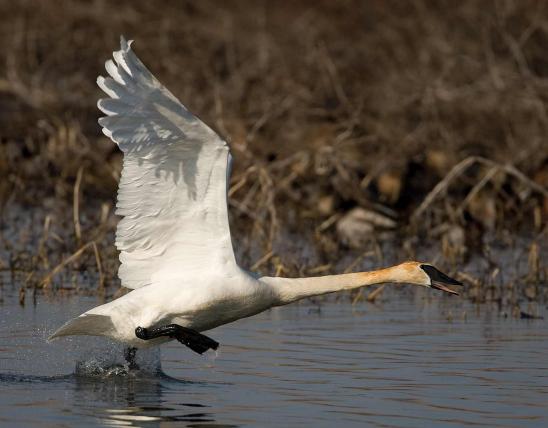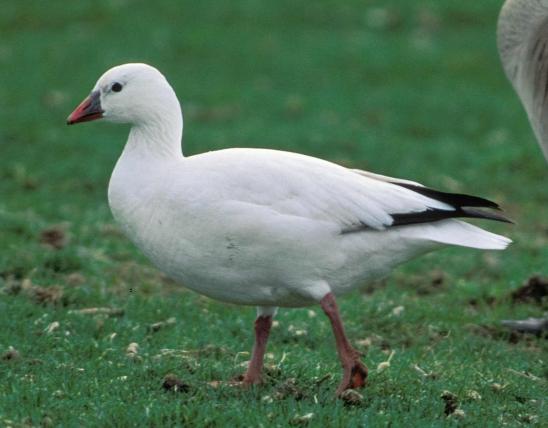
The mute swan is a native of Eurasia that had been transplanted to America. It lives not only in parks and zoos but also, now, in natural habitats. In Missouri, it is seen in winter on rare occasions.
The mute swan is distinguished from other swans that occur in our state by its arched neck, orange bill, and black forehead knob. The white plumage and graceful contours of this beautiful, floating bird belies its aggressive nature, especially during nesting time.
Despite the name, mute swans are not silent. The call is quick, with two parts, almost like an “ah-choo” sneeze that ends with a snort: “Ah, Pfrrrrt!” The first part ascends in pitch, the second part is something like a whoopie-cushion sound. Other sounds include grunts, snorts, and deep, intimidating hisses. In flight, the wings make humming, droning, whooshing sounds (our other swans have relatively noiseless wingbeats).
Similar species: Missouri’s two other swans are the trumpeter swan and the tundra swan. They are both native to North America. Both lack the orange bill and black forehead knob; both tend to hold their necks fairly straight upright, with the head and bill at about an right angle to the neck (not arched in an S-curve).
Large white birds flying overhead are sometimes difficult to identify. Often white plumage appears black when the sky behind them is light. People often confuse swans and geese; swans are larger and have proportionately longer necks.
Length: 60 inches (tip of bill to tip of tail). More than twice the size of a snow goose.
Potentially statewide, in appropriate habitats.
Habitat and Conservation
In Missouri, the mute swan most commonly is seen on ponds and lakes at parks and zoos, essentially in captivity. But in natural places, you may sometimes see it in wetlands, lakes, ponds, and other slow-moving aquatic habitats, especially in winter.
The Missouri status of this European native swan is uncertain; in Missouri, it is seen in winter on rare occasions. Although established on the Middle Atlantic coastal region and around the Great Lakes, it has apparently not become established in Missouri. Sightings may be of individuals escaped from captivity or of naturalized birds from breeding areas in Illinois.
Food
Mute swans eat a great volume of food each day: mostly various aquatic plants, including emergent, floating, and submerged grasses, pondweeds, filamentous algae, and more. They root up tubers of aquatic plants. They also eat grains from crop fields. In addition to plant materials, they also prey on frogs and tadpoles, fishes, insects, snails, and other animals they can capture and swallow.
In zoos and parks, they consume foods given to them by people, including grains, various food scraps, and waterfowl food pellets.
Status
Introduced; not native to North America. Native to Eurasia. Considered invasive in several places in North America.
In Missouri, as winter resident, uncommon in the St. Louis area, rare elsewhere; as summer visitor, rare; as summer (breeding) resident, accidental.
Life Cycle
Mute swans are not native to North America, but introduced populations have become naturalized and now breed on our continent, and they have been spreading. So far, they only occasionally breed in Missouri.
Males begin nest construction near water, among heavy vegetation, building it from gathered plant materials. When the female takes over nest construction, the male brings additional twigs, grasses, aquatic plant stems, and so on for her to work with. These nests can be 5 feet wide and 2 feet high.
A clutch comprises 2–5 eggs, which are incubated for 34–41 days. The young are able to start walking around in the nest within hours of hatching, and they can fly 65 days later. In North America, mute swans have been known to live for nearly 27 years in the wild.
Human Connections
People purposefully introduced mute swans into North America. They were introduced in order to look pretty on park ponds and lakes, primarily in large eastern cities. With breeding populations now well established and living in natural areas, they are causing problems in many places as a nonnative invasive species.
The mute swan can be aggressive, which is a good reason not to establish it near people, especially children. Nesting mute swans can attack humans who venture too close to their nests or chicks. They have seriously injured people and pets.
Because mute swans are monogamous and form long-term pair bonds, many people see them as symbols for human love.
The beauty of swans is undisputed. In their native Eurasia, mute swans are the national bird of Denmark. They were the inspiration for Hans Christian Andersen’s story “The Ugly Duckling.” They have strong associations with the British monarchy.
In western Europe, wild populations of this species were long ago nearly extirpated due to overhunting, but poultry interests kept them going long enough for conservation measures to help wild populations rebound. In the late 1900s, swans in England had declined because of lead poisoning, brought about by birds ingesting lead shot from guns and fishing weights.
One of the most famous ballets of all time is Swan Lake, composed by Pyotr Ilyich Tchaikovsky and first performed in 1877. It’s based on Russian and German folk stories and tells the tale of a princess who is changed into a swan by a curse. The beautiful dancing and the passionate music carry the show. The super-famous oboe solo, performed as the curtain rises for the time, helped to make that instrument the unofficial musical voice for waterfowl.
Ecosystem Connections
Mute swans have little place in the natural ecosystems of North America. Here are some of the problems they cause:
They gobble up large amounts of submerged aquatic vegetation, outcompeting native animals that eat the same food, and removing that vegetation (and the habitat it provides) from native animals that would ordinarily live among it.
They are also very aggressive, especially at nesting time, and these large, imposing birds chase away many kinds of animals, including ducks, geese, and other swans, and even people and dogs. They can kill small enough interlopers.
Adult mute swans have few natural predators.
In places where they create large breeding grounds, mute swans tend to drive away or simply trample the nests of native terns and skimmers, eliminating whole breeding colonies of those birds. Thus they outcompete many native species for both food and habitat.
Sometimes they displace native species, such as native least terns and trumpeter swans, that are already in decline.
This is why, in several places in North America, mute swans are considered invasive.
Because mute swans are not native to North America, and they outcompete or displace native species, wildlife managers have attempted to control mute swans by a variety of means, such as addling the eggs (ending the possibility of chicks developing) and killing adult birds. People who appreciate swans aesthetically can be uncomfortable with these efforts, but North American species like black skimmers, least terns, black terns, and our native trumpeter swans may depend on controlling and removing the nonnative waterfowl.
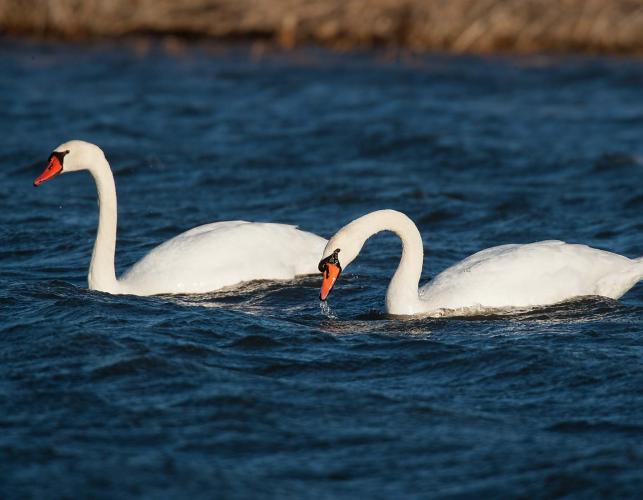

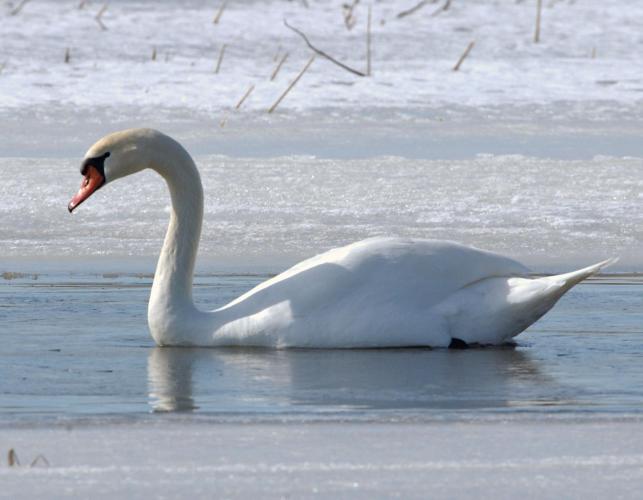
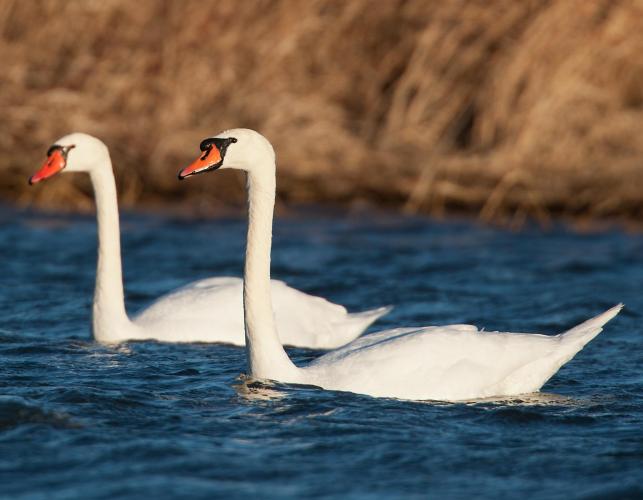
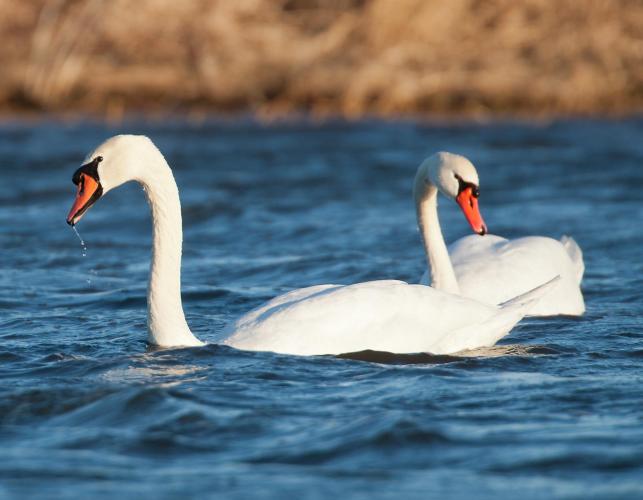
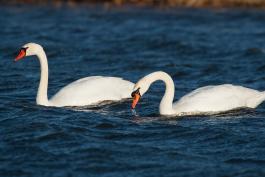
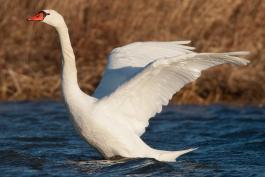
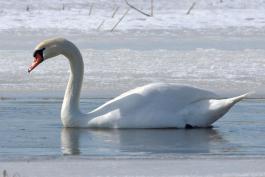
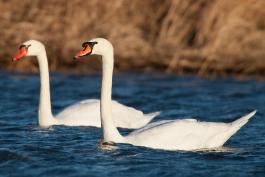
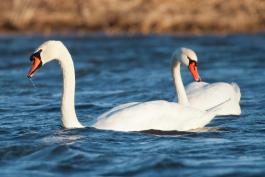
About 350 species of birds are likely to be seen in Missouri, though nearly 400 have been recorded within our borders. Most people know a bird when they see one — it has feathers, wings, and a bill. Birds are warm-blooded, and most species can fly. Many migrate hundreds or thousands of miles. Birds lay hard-shelled eggs (often in a nest), and the parents care for the young. Many communicate with songs and calls.






















